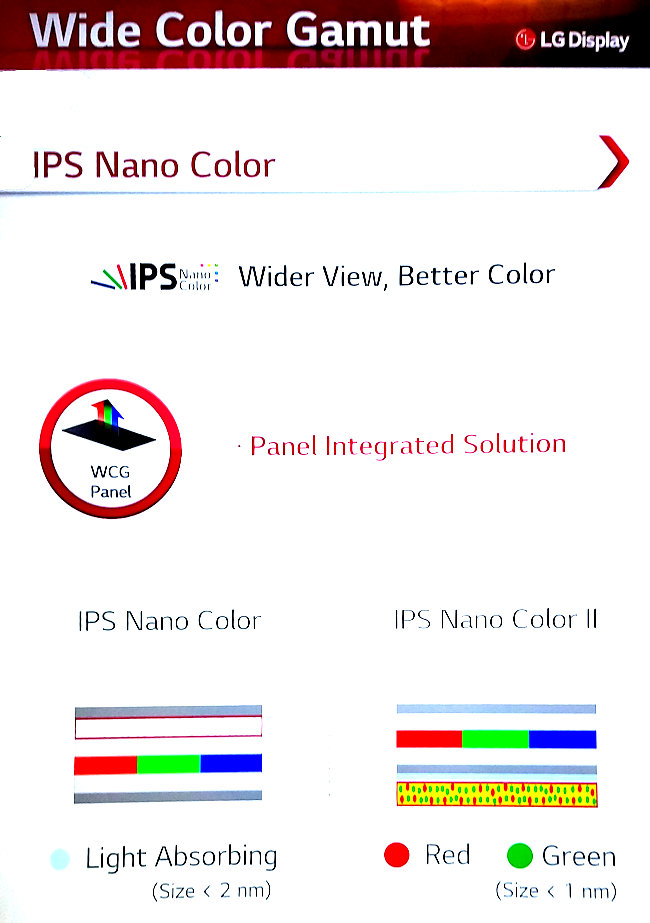Let me be clear. Nobody from LG said this to me at CES or anywhere else, but LG is notable for not using quantum dots in its higher-level TV sets. However, with wide color gamut becoming a requirement for high-end UHD sets, this is becoming an untenable position — or is it?

In its booth on the CES show floor, LG Electronics had an elaborate but largely incomprehensible display promoting its new “nano-cell display.” LG claimed “accurate colors maintained at any angle” for its new technology, and also claimed that colors are enhanced. The company said the nano-cell technology consisted of 1-nanometer particles uniformly distributed on the LCD cell. There was also the nonsensical suggestion on a poster (although not an outright statement) that nano-cell is better than quantum dots because the particles are significantly smaller.
What was very hard to understand, both for attendees and booth personnel, is just what nano-cell technology does. Some people, though, did understand, and they could be found in the LG Display (LGD) by-invitation-only suite in the Las Vegas Convention Center’s North Hall.

What LG was calling “nano-cell display” on the show floor, LGD was calling “IPS NanoColor,” of which there are two distinct types. The current version, which is what LG was showing, is called just IPS NanoColor. Here, the nanoparticles — which are approximately 2nm in diameter, not one nanometer – are indeed distributed on the front surface of the LCD, where they serve as a color filter and, perhaps, as a diffusion layer that improves the viewing angle. (For more on the filter use, see There’s More than One Way to Make a WCG LCD)
Since it serves as an additional color filter, the IPS NanoColor layer obtains its increase in color purity at the expense of some efficiency. LGD said the technology delivers a color gamut of 90% DCI-P3, compared to 96% for quantum dots. However, they claim a BLU efficiency of 78%, in contrast to QD’s 70%. I would need to be convinced of that last pair of numbers. (Samsung had something similar last year in its sets, which may give a clue as to why the UHD Alliance set its ‘Premium’ colour requirement at 90% of P3 – Man. Ed.)
LGD also claims that with IPS NanoColor the color gamut at 80 degrees is still 91% of what it is normal to the screen surface, while the equivalent QD number is 28%. I look forward to seeing if independent testing supports these numbers.

Generation II
The second-generation technology, IPS NanoColor II, takes a different approach. Here, the backlight uses blue LEDs, and 1nm nanoparticles are arrayed between the LCD cells and the backlight. Some of these nanoparticles convert the blue light to red, while others convert to green, as quantum dots do. But these particles are too small to operate on the basis of quantum confinement. Another possibility is that these are phosphor particles, but phosphor particles are typically 50-100 times the diameter of LGD’s particles. It was at this point that the LGD engineers reached the limit of what they were allowed to say.
They could say that the particles had been developed in cooperation with LG Chemical. Has LG Chem develop super-nano phosphor particles? Time, undoubtedly, will tell.
NanoColor II, LGD said, will have a color gamut about the same as QDs, with a BLU efficiency slightly less than the first-gen NanoColor, but still slightly more than QD. The LGD reps suggested we could see it in TV sets in 2018
For now, it will be very interesting to compare Samsung’s impressive new quantum-dot technology — which Samsung erroneously calls “QLED” — with the first-gen IPS NanoColor. Ray Soneira, are you listening? – Ken Werner
Ken Werner is Principal of Nutmeg Consultants, specializing in the display industry, manufacturing, technology, and applications, including mobile devices and television. He consults for attorneys, investment analysts, and companies re-positioning themselves within the display industry or using displays in their products. You can reach him at [email protected].

